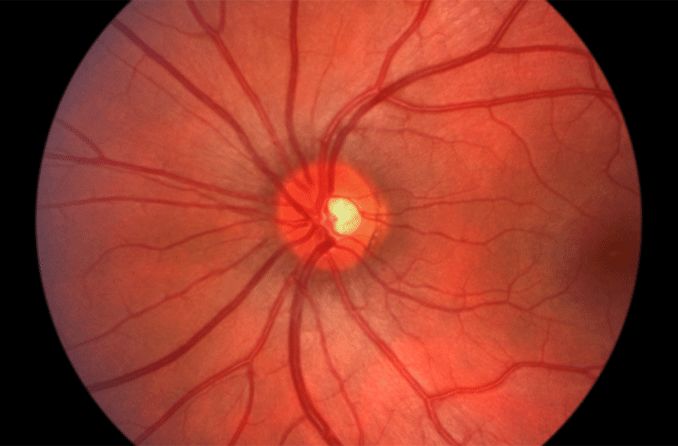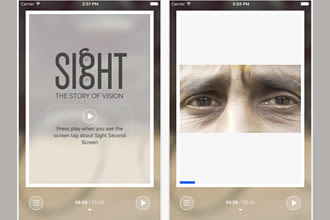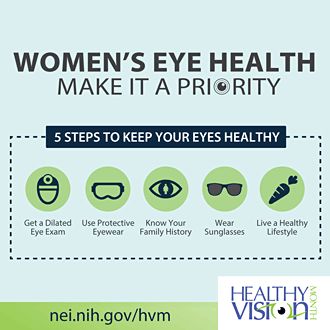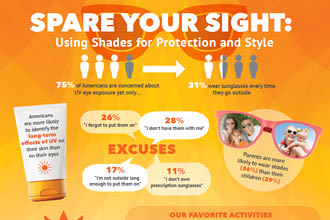Vision and eye news

Schedule an exam
Find Eye DoctorFDA approves first drug to treat thyroid eye disease
By John Egan
January 2020 — The U.S. Food and Drug Administration (FDA) on Jan. 21 approved the first and only treatment for a rare eye condition known as thyroid eye disease.
Dr. Wiley Chambers, a Washington, D.C., ophthalmologist who is deputy director of the ophthalmology division at the FDA’s Center for Drug Evaluation and Research, said approval of the medication, called Tepezza (teprotumumab), “marks an important milestone for the treatment of thyroid eye disease.”
Thyroid eye disease (TED) — also called Graves’ eye disease — is a rare, progressive and vision-jeopardizing autoimmune disease associated with proptosis (eye bulging), diplopia (double vision), blurred vision, pain, inflammation and facial disfigurement. Each year, about 1 million Americans are diagnosed with TED.
READ MORE: FDA approves first drug to treat thyroid eye disease
Diabetes + sleep apnea raises risk for vision loss
By John Egan
October 2019 – If you have diabetes and severe sleep apnea, you are at high risk of developing an eye condition that can lead to vision loss and blindness, new research finds.
The eye condition is diabetic macular edema, and the study, conducted over an eight-year period at Chang Gung Memorial Hospital in Taiwan, found the degree of a person’s sleep apnea correlates with the severity of the patient’s diabetic macular edema.
Previous research indicated a weak relationship between diabetes and sleep apnea.
“Based on these results, we hope that more medical professionals will approach sleep apnea as a risk factor for diabetic macular edema,” said Dr. Juifan Chiang, the study’s lead researcher. “This could allow for earlier medical intervention so patients can keep more of their vision and preserve their overall health as much as possible.”
What is diabetic macular edema?
Diabetic macular edema, or DME, is triggered when blood vessel leakage from diabetic retinopathy causes fluid to build up in the macula, the part of the retina responsible for visual acuity and color vision.
This study suggests that sleep apnea may contribute to the development and worsening of diabetic retinopathy by boosting insulin resistance, increasing inflammation and raising blood pressure.
Poor control of blood sugar and other medical issues — including high blood pressure — raise the risk of blindness for people with DME, which can happen at any stage of diabetic retinopathy.
Prevention, detection and treatment
To prevent diabetic macular edema, the nonprofit Prevent Blindness recommends that you:
Maintain good levels of blood sugar, blood pressure and cholesterol.
Undergo a comprehensive dilated eye exam at least once a year.
Exercise regularly.
Stick to a healthy diet.
If you notice any significant changes in your vision (even if you don’t have diabetes), check in with your eye doctor immediately. Symptoms of diabetic macular edema include:
Sudden increase in eye floaters
Treatment for DME includes:
Laser therapy to close and destroy leaking blood vessels.
Anti-vascular endothelial growth factor (anti-VEGF) drugs, which block development of new blood vessels and restrict leakage from abnormal blood vessels in the eye.
Steroids injected into the eye or released over time by an injectable eye implant.
WHEN WAS YOUR LAST EYE EXAM? Find an eye doctor near you and schedule an appointment.
2.2 billion have impaired vision, WHO report finds
October 2019 — More than 2.2 billion people have vision impairment or blindness, according to the World Health Organization’s first “World Report on Vision.”
More than 1 billion of those people have conditions like myopia, hyperopia, cataracts and glaucoma, which could have been prevented or have not yet been treated.
The WHO report, which was published ahead of World Sight Day (October, 10, 2019), determined the following factors have led to increased rates of visual impairment:
Aging populations
Changing lifestyles (e.g., less time outside, more time on-screen)
Limited access to eye care (e.g., people with low incomes and those living in rural areas)
Late detection of vision problems
“It is unacceptable that 65 million people are blind or have impaired sight when their vision could have been corrected overnight with a cataract operation," said Dr. Tedros Adhanom Ghebreyesus, WHO’s director general.
Also alarming is "over 800 million struggle in everyday activities because they lack access to a pair of glasses,” he added.
While advocacy efforts have made great progress in global eye care in the last 30 years, major challenges still lie ahead.
For continued improvement, WHO recommends making eye care an essential part of universal health coverage and implementing a system of integrated people-centered eye care to empower and engage people and their communities.
SEE RELATED: 6 ways you can give the gift of vision on World Sight Day
5 healthy vision tips for young adults
May 2019 — You may have heard that the eyes are windows to the soul — but did you know that your eye health is closely related to your overall physical health? Taking care of your health now can help decrease your risk of vision loss and blindness in the future.

That’s why the National Eye Institute (NEI), part of the National Institutes of Health, is encouraging adults ages 25 to 35 to make vision a priority during Healthy Vision Month 2019. The message is clear: young adults can take steps now to help prevent vision loss later in life.
Take these steps today to stay healthy and protect your vision:
Eat a healthy diet. Choose lots of veggies (like kale, spinach, and orange bell peppers), fruits (like blackberries and raspberries), and try to eat fish. And, as your grandparents might have told you, eat your carrots!
Stay at a healthy weight. Maintaining a healthy weight can lower your risk for diabetes and high blood pressure — conditions that can lead to vision loss and blindness.
Wear sunglasses - even on cloudy days! Sunglasses can protect your eyes from the sun’s ultraviolet (UV) rays and help keep your vision sharp. Choose sunglasses that block at least 99 percent of both UVA and UVB radiation. Wear a wide-brimmed hat when you’re outdoors for extra eye protection.
Quit smoking. Research shows that smoking can increase your risk of eye diseases, like cataracts. If you smoke, talk with your doctor and make a plan to quit.
Give your eyes a rest from screen time. When you’re working at a screen, practice the 20-20-20 rule: every 20 minutes, take a 20-second break to look at something 20 feet away.
About the author ─ Anju Goyal, M.D., is an associate professor of Ophthalmology and director of Medical Student Education at Kresge Eye Institute, the Department of Ophthalmology of the Wayne State University School of Medicine. She is also a member of the National Eye Institute’s National Eye Health Education Program Planning Committee.
Ladies, make your eye health a priority this month!
May 2017 — All About Vision is partnering with The National Eye Institute for Healthy Vision Month by encouraging women to make eye health a priority. Women are more likely to have eye-related conditions like cataracts, glaucoma and age-related macular degeneration. So ladies, make sure you take care of your eyes!
Throughout the month of May, you can celebrate Healthy Vision Month by encouraging the women in your life to follow these five steps for protecting sight:
Get a dilated eye exam, so your eye doctor can perform a thorough evaluation of the health of your eyes.
Live a healthy lifestyle by eating nutritious foods and maintaining a healthy weight.
Learn about your family's history with eye health. Do eye conditions run in your family? If so, let your eye doctor know at your next visit.
Use protective eyewear in any instances where your eyes may be at risk: playing sports, on the job, home repairs, etc.
Wear sunglasses to protect your eyes from the sun's harmful UV rays. Make sure your shades block 100 percent of UVA and UVB radiation.
It's easy to get caught up in a busy life, balancing work and family, but eyesight should be a priority. Taking the steps above could help prevent vision loss and blindness from eye diseases.
Please click here to learn more about Healthy Vision Month. — N.B.
New eBook and app to help tell 'The Story of Vision'
October 2016 — Don't forget to see the new documentary Sight: The Story of Vision, starting on October 13, World Sight Day!
In the meantime, a companion eBook has become available for download from the iBooks store and the documentary website.

The author, Mark Mattison-Shupnick, ABOM, said he created the book as a "deeper dive" into the many topics covered by the documentary. (Mr. Mattison-Shupnick is a master optician who is also an All About Vision editorial advisory board member.)
The book is viewable on iPads, Kindles, other eBook readers, other IOS and Android devices, and computers.
Plus, you can download the Sight: Story of Vision Second Screen App, also available on the documentary website and directly from Apple's App Store. The app provides terminology definitions related to the documentary as well as expanded video content.
The eBook was underwritten by a grant from contact lens manufacturer CooperVision. Development of the app was supported by eyeglass lens manufacturer Essilor.
No more specs in passport photos
October 2016 — You may love how you look in your glasses, but the U.S. Department of State says that starting this November, you can't wear them when having your passport photo taken.

The U.S. Department of State hopes that eliminating eyeglasses from photos will speed up passport application processing.
Why? According to a Department news release, in 2015 more than 200,000 travelers submitted passport applications with unacceptably poor-quality photos. The number one reason? Eyeglasses.
It's bad enough that people send in dark, blurry, poorly cropped passport photos, but wearing glasses can make the problem even worse.
People look different with their eyeglasses on than when they're off, making identification difficult. Frames can throw confusing shadows on faces, and lenses may have glare spots from the camera flash. Tinted lenses can obscure features and change eye color.
The Department hopes the rule will reduce passport application delays and wait times at U.S. ports of entry. If your passport is unexpired, you're fine. The rule applies only when you renew a passport or get one for the first time.
Need your glasses to stay on for medical reasons? Get a signed statement from a medical professional and submit it with your passport application.
Elton John narrates new documentary on vision
September 2016 — Sight: The Story of Vision, a documentary on scientific, medical and technological aspects of human vision, is set to premiere on October 13 (World Sight Day).
The one-hour film will broadcast on public television and features Sir Elton John as narrator.
It tells the story of how people discovered how our eyes work, as well as how to improve our eyesight and even restore it when it is lost.
Online content will also be available for viewers of Sight: The Story of Vision, in the form of apps and a downloadable eBook here.
One interesting detail about the documentary is that its writer and director Kris Koenig decided to apply color correction to the film so people with red-green color confusion could distinguish those colors better while watching. He did this after trying a pair of EnChroma eyeglasses, which are custom-tinted to help people with various types of colorblindness.
Please check your local TV listings for broadcast times and dates. Watch the trailer.
FDA approves new prescription eye drop for dry eye disease
July 2016 — A twice-daily eye drop called Xiidra (lifitegrast ophthalmic solution) 5% has received FDA approval for treatment of both signs and symptoms of dry eye disease in adults. The biotechnology company Shire manufactures Xiidra and plans to launch it in the United States this quarter.
"The clinical program supporting the approval of Xiidra is the largest for an investigational-stage dry eye disease candidate to date, including more than 2,500 patients," said Edward Holland, MD, in a company release. Dr. Holland is professor of clinical ophthalmology, University of Cincinnati, and a clinical trial investigator for Xiidra.
"The clinical trial program design took into consideration many of the challenges of past dry eye research," he continued. "It's exciting to see Xiidra as the first prescription eye drop FDA-approved for both the signs and symptoms of the condition."
In the safety/efficacy study, 1,067 patients received the drops in four placebo-controlled 12-week trials. In two of the trials, an improvement in the patient-reported eye dryness score was seen at two weeks. In three of the trials, an improvement in the inferior corneal staining score was seen at 12 weeks.
The most common adverse reactions reported in 5 to 25 percent of patients were instillation site irritation, altered taste sensation (dysgeusia) and reduced visual acuity.
Celebrate National Sunglasses Day
June 2016 — Monday the 27th is The Vision Council's National Sunglasses Day, but protecting your eyes from the sun's UV rays is important every day.
The more exposure your eyes have to sunlight without sunglasses throughout your life, the greater your risk of cataracts, macular degeneration and more — even on cloudy days. After a day in the sun without sunglasses, UV rays can also cause immediate, temporary issues like red eyes and sensitivity to light.
Don't let excuses prevent you from protecting your eyes. Get multiple pairs of sunglasses and keep spare shades in your car, so you're not caught without them.
According to The Vision Council, these are the top four excuses for not wearing sunglasses while outdoors:
"I don't have them with me" — 28%
"I forgot to put them on" — 26%
"I'm not outside long enough to put them on" — 17%
"I don't own prescription sunglasses" — 11%
Celebrate National Sunglasses Day by making sure your family always wears shades while outside. On June 27, post a sunglass selfie to your favorite social media outlet with the hashtag #NationalSunglassesDay to promote the importance of UV protection for eyes. — N.B.
Zika virus now thought to cause retinal lesions
February 2016 — The Zika virus has quickly reached epidemic proportions in Brazil and is now rapidly spreading to other parts of the Americas — including Hawaii, where the Centers for Disease Control and Prevention have confirmed the birth of a microcephalic baby whose Brazilian mother was infected with Zika.
It is estimated that, in 2015 alone, more than one million Brazilians have had Zika virus infections. The infection, which is usually transmitted by the Aedes aegypti mosquito, is rarely life-threatening. Typically, individuals experience a short-lived fever, nonspecific rash and joint pain. Conjunctivitis, muscle pain and headache have also been reported. Some experience no symptoms at all.
But when infection occurs during pregnancy, complications are far more severe, most often causing microcephaly. In fact, six months after the onset of the Zika outbreak in Brazil, there was a 20-fold increase in newborns with microcephaly. By January 4 of this year, the Brazilian Ministry of Health had reported 3,174 microcephalic newborns.
Now, according to a study report published in JAMA Ophthalmology, it appears that microcephaly isn't the only risk that Zika poses to newborns. In the study, nearly 35 percent of 29 babies with presumed Zika virus-associated microcephaly also have vision-threatening lesions — most often on both of their retinas.
Millions of people are believed to have been infected with the Zika virus. And in Brazil, where it's spreading fastest, testing for Zika is not readily available. In the U.S., the Centers for Disease Control and Prevention can perform serologic testing. However, the mild nature of the symptoms means the illness often goes unnoticed and isn't reported.
Considering that the infection causing microcephaly and retinal lesions typically occurs during the first or second trimester of pregnancy, it has been suggested that women in the areas of the epidemic consider not getting pregnant. And it is recommended that pregnant women, especially during their first two trimesters, not travel to areas where the disease is epidemic.
Ed. note: For helpful fact sheets on the Zika virus, protecting your family from mosquito bites, controlling mosquitoes and traveling while pregnant, please visit the CDC website .
Hard-to-read card may have tripped up Steve Harvey
December 2015 — Did carelessness, excitement, nerves, spotlights or presbyopia cause Steve Harvey to announce mistakenly that Miss Colombia had won the Miss Universe title instead of Miss Philippines?
Nobody knows for sure. But we suspect that partly to blame was the design of the card that Harvey was referring to when he announced the winner.
The layout is inconsistent, for one thing. And the type size is minuscule!
We don't know what kind of vision correction Harvey uses, or whether he has had presbyopia-correcting surgery. Hopefully, the next time he's called upon to read something onstage, it will be designed for a middle-aged person to read.
3 ways climate change can harm your eyes
December 2015 — Most of the body's organs are internal, which helps shield them from direct environmental assault. But the eye, which is one of the most essential and complex sensory organs we have, is largely unprotected most of the day. This leaves it particularly vulnerable to environmental factors like climate change.
The dangers posed by environmental factors have been researched extensively in recent years and were the subject of a recent National Institutes of Health symposium that focused on the impact of climate change on human health.
At the meeting, Sheila West, PhD, vice chair for research at the Wilmer Eye Institute, Johns Hopkins University, detailed the three most likely ways that environmental change can affect our eyes.
The first has to do with the expansion of arid regions in the United States and around the globe. As areas of the planet get hotter and less humid, people who suffer from dry eye may see an escalation in symptoms. And since dry eye doesn't always produce symptoms early on, more and more people may recognize that they have the condition and start seeking treatment that they may not have otherwise needed.
Climate change also can affect our eyes due to increases in airborne particulates. Dr. West pointed to longer fire seasons and crop clearing as key offenders, emitting pollutants that can cause serious harm to the eyes. In fact, in Dr. West's own research, eye irritants from smoke emitted by cooking fires led to increased scarring of the eyelids and cornea in people with trachoma, which is the leading infectious cause of blindness worldwide.
A third way that environmental changes can be harmful to our eyes relates to depletion of the protective ozone layer in the Earth's atmosphere, which absorbs most of the damaging (UV) rays emitted by the sun. Though recent international treaties may help reverse damage to the ozone layer, the repair will take decades. In the meantime, UV exposure remains a risk factor for cataracts and other eye diseases.
Dr. West estimates that UV exposure will lead to an additional 150,000 to 200,000 cases of cataract by 2050, with a price tag exceeding one billion dollars for care and surgical treatment. And that's in addition to the huge number of cases that would otherwise be diagnosed.
Why you see yellow on a digital screen — even when it's not there
November 2015 — When you look at a picture of a lemon on a digital screen, be it on a phone, tablet, or your desktop, what color is it?
If you think it's yellow, you're wrong.
An interesting video by Vsauce called "This Is Not Yellow" explains how digital screens can fool our brains into seeing certain colors, even when those colors aren't actually being displayed.
The video also discusses optical illusions created by modern artists, electricity given off by fruits and how quickly historical events can slide out of our collective memory. Enjoy!
Page published on Wednesday, February 27, 2019






